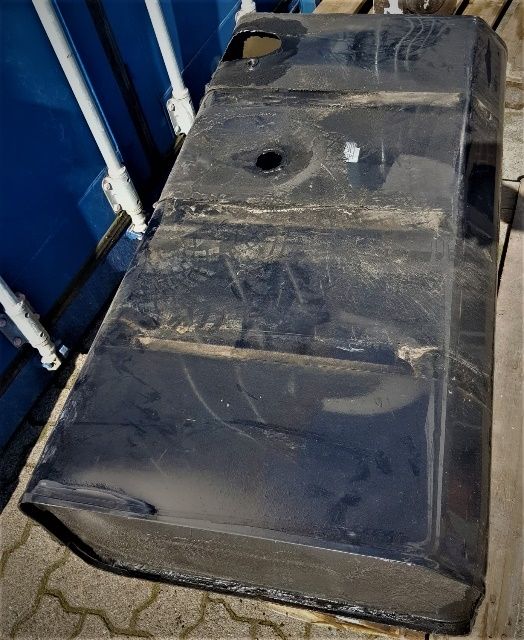Service tank
Here are some examples of what can happen on and in a tank:
Seam leaking:

Unfortunately, the seam is always a problem area on fuel tanks. They usually consist of two deep-drawn sheet metal parts that have been welded together with a rolled seam. This type of production is used on most mass-produced tanks because it is very inexpensive to manufacture.
Since there is an air gap in the seam up to the roll seam (due to manufacturing), water enters the gap and starts to corrode.
The corroded metal becomes larger in volume due to oxygen absorption and pushes the roll seam apart.

That is why it is important to seal the gap during restoration.
We have had good experience with the product Owatrol. This is a penetrating oil that contains a synthetic resin. It penetrates the gap and seals the rust by curing. The material can be painted over after curing.
Once the rolled seam is open, there are two options. Cut open the seam, clean it and weld it again. Or seal the inside of the tank with an internal tank coating. However, I would only recommend coating the inside of the tank as a last resort. You can never get the coating out of the tank again.
We do without such constructions and tack weld the folded end bottoms of thin-walled tanks up to 2 mm by spot welding and weld the sheet edges tightly so that no water can penetrate from the outside.


Rust in the tank

The most frequently asked question from our customers is “how did it get in there”? There can be many ways. But one thing is a prerequisite. Water in the tank.
Fuels will always contain a certain percentage of water. This can come from a variety of sources. e.g. water can be from incorrect refueling such as from canisters (old overstocked fuel) leakage into the tank (rain, high pressure cleaning...) ingress from the atmosphere (moisture) human error (unprotected vents, fill ports, seals...) Or even from the supplier.
With correct refueling, however, the aim is to keep the water content within acceptable limits - well below the saturation point.
This is because the water molecules remain part of the fuel until there are too many of them. The point at which the fuel can no longer absorb any more water is known as the saturation point. As long as the water remains below the saturation point as dissolved water, it is not normally too much of a problem. Significant problems arise when water separates from the fuel and becomes free or emulsified water. Emulsified water is another form of free water; the droplets are so small and so well mixed into the fuel that they float in it and do not settle to the bottom. There are no “droplets” when water is completely dissolved in the fuel. Until then, this is still acceptable for the tank. Problems can arise here with the engine and injection pump.
However, if the water content becomes so high that the “droplets” combine to form droplets and settle to the bottom, the water reacts with the metal and rust occurs. Temperature differences can also cause free water to condense on the top of the tank and form water droplets. This can cause the tank to rust completely in a short space of time.
In addition, water can be caused by incorrect refueling, e.g. from canisters (old, overstocked fuel), leakage into the tank (rain, high-pressure cleaning, etc.), penetration from the atmosphere (moisture), human error (unprotected vents, filling connections, seals, etc.) or even from the supplier.
If the tank is not so badly damaged that it looks like a “Swiss cheese”, we can weld or solder a “patch” onto the leaks and remove the rust from the tank. We then check it and treat the inside with an anti-corrosion oil. It can then be stored dry for up to a year. The tank can then be refilled without any problems. The anti-corrosion oil washes out with the fuel and does not damage the engine.
We also offer tank sealing, but I would advise against this for the time being. A tank sealant is always the last option to preserve a tank that can no longer be purchased. This is because we have many customers who come to us with an old, sealed tank. The sealant or paint is peeling off on the inside. Good. Of course, it has to be said that these old coatings were not as good as today's ones.
Unfortunately, the inner coating cannot be completely removed again. If it comes off, the fuel filter will always become blocked again.
In most cases, a coating is not necessary. If the structure of the tank is still good and does not look like a “holey watering can” after rust removal, everything is fine.
Slime and deposits in the tank:




In the presence of free water, the chemical molecules sometimes detach from the hydrocarbon chain of the additive and combine with water molecules to form a new substance. The new material is a soft solid that separates from the fuel and can quickly clog filters or form engine deposits.
Microbial growth: Like most living organisms, bacteria and fungi (molds) need both food and water to survive. When free water is present, microbial growth can increase, creating slimes that contaminate your fuel and acids that corrode your tank and fuel system.
Fuel oxidation: Free water accelerates the oxidation process and promotes the formation of acids, gums and sediments, commonly known as fuel degradation products.
After chemical cleaning, many residues can be removed and the tank can resume its work.




